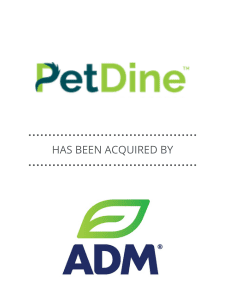Pet Food & Treats
TABLE OF CONTENTS:
- CH. 1: Introduction
- CH. 2: Market Overview & Trends
- CH. 3: Key Players in the Pet Food M&A Market
- CH. 4: Recent Deal Flow and Multiples
- CH. 5: Challenges that Drive Pet Food Businesses to Pursue an M&A Transaction
- CH. 6: What Buyers Look for in a Pet Food Target Business
- CH. 7: What to Consider Before Selling Your Pet Food Business
- CH. 8: Key Considerations for Growing Your Pet Food Business Through Acquisition
- CH: 9: How to Raise Capital for Your Pet Food Business
Chapter 1
Introduction to the Pet Food & Treats Industry
The pet industry has enjoyed tremendous growth in recent years, with the pandemic fueling higher rates of pet ownership and total spend showing great resilience in the face of persistently high inflation. In fact, an American Pet Products Association (APPA) study found that about two-thirds of pet food shoppers don’t plan to alter their buying habits even if economic conditions worsen. The robust growth and staying power of the pet sector has spurred significant interest among investors, especially within the dominant category of pet food and treats.
If you own a pet food and treats company, you may be wondering how the market is trending, whether now is a good time to sell the business or take on a majority investor, and what you should consider before taking your company to market. This guide can help answer your questions.
In this guide to M&A in the pet food and treats sector, you’ll learn about the pet food market’s current and projected growth, the trends driving consumer behavior in this category, and why investors find this sector appealing right now. The guide also reviews recent deal activity in the pet food and treats category, the major players involved, what buyers look for in a target pet food business, what to think about before selling your company, or acquiring a pet food business, how to raise capital, and why Forbes is the right partner to help you achieve an exceptional outcome when you’re ready to exit your pet food business or need to raise capital.
The global pet food market is expected to grow at a compound annual growth rate (CAGR) of 11.1% over the next four years, with forecasts that 2023 sales will top $147 billion.
Chapter 2
Market Overview & Trends
While most subsectors within the pet category are currently performing well, the pet food business is booming—and that’s attracted strong attention from investors.
The global pet food market is expanding at a rapid rate and there is little evidence of slowing. The market is expected to grow at a compound annual growth rate (CAGR) of 11.1% over the next four years, with forecasts that 2023 sales will top $147 billion. The growth trajectory for the pet food market in the US is even sharper, with an anticipated CAGR of 23.71% from 2022 to 2027.
The pet food sector was already experiencing healthy growth pre-pandemic; then the COVID-19 lockdowns spurred more consumers to welcome a pet into the family. It was the perfect time to add a new companion and a convenient time to get a pet acclimated to the home (especially puppies that need a lot of training). And unlike some sectors that saw only temporary spikes in demand due to pandemic-induced behavior changes, the pet food sector has proven immune to behavior reversals. As a result, many pet food companies still boast strong fundamentals, including accelerating revenue and more attractive margins than most consumer products.
Further fueling the sector’s growth is pet owners’ willingness to spend liberally on healthy food for their companions. That’s led more companies to introduce new options that capitalize on two of the most significant, interrelated trends in the pet food sector: premiumization and humanization. Much like consumers are increasingly choosing clean, healthy foods for themselves, pet owners expect those same options when it comes to pet foods—and they’re willing to pay a premium for them.

Today’s pet owners look for foods that rival what they would eat, seeking some of the same features and functionality as they do in human food. Pet foods perceived as premium have high appeal, especially those that are:
-
- Organic
- Non-GMO
- Vegan
- Kosher
- Free from artificial colors or preservatives
- Made with sought-after functional ingredients like probiotics
Similarly, the sustainability trend is permeating every product category, spurring many consumers to choose food packaging that is recyclable or made from recycled materials and ingredients that are responsibly sourced. Although environmental considerations play a less important role than quality in the pet food purchase decision, concerns about being left behind have many brands taking steps to position themselves with the eco-conscious consumer.
In the face of these trends, pet food businesses recognize that if they expect to succeed, they need to invest in innovation. They’re leveraging advanced manufacturing techniques to offer pet owners super-premium options, such as:
-
- Raw or fresh foods
- Novel wet-food formats such as stews and purees
- Freeze-dried foods
- Innovative proteins like kangaroo and bison
- Human-grade meats
- Plant- or fish-based foods
With major players like Mars Petcare investing heavily in their wet food manufacturing capabilities, and Petco Health and Wellness partnering with JustFoodForDogs on a new line of fresh and frozen dog food, all evidence points to super-premium pet foods remaining on a fast-growth trajectory.
Despite rising costs for their own food and other essentials, pet food appears to be a protected area of spending for most consumers—another trend that will propel robust growth for premium brands, even in challenging economic times. While a small segment of consumers might pull back on pet food spending, their behavior changes are expected to be minimal and the focus should remain on high-quality selections.
Given this sector’s strength, it’s not surprising that investors view the pet food and treats sector as an attractive market to deploy their capital. In fact, the pet category was one of the few that showed resilience during the height of the pandemic, posting a record year for M&A in 2021.
The industry has seen a wave of acquisitions, yet there are still many well-run branded pet food companies and co-manufacturers that are likely to attract investor attention. Additionally, private equity (PE) groups have a great deal of dry powder to deploy and many strategics have healthy balance sheets. Whether it’s a large strategic snapping up well-run smaller companies or a PE group rolling up multiple specialty businesses, what is now a highly fragmented market will begin to consolidate over time as the deal momentum continues.
And while the US remains a hot market for pet food M&A, cross-border transactions are on the rise among both PE groups and strategic acquirers.
Over the past three years, cross-border transactions accounted for 66% of the pet food company deals, with financial buyers especially active in this arena. Eager to expand their geographic reach, some of the major European brands have their eye on acquisition targets in the US. Conversely, US-based pet food businesses see an opportunity to boost their valuations by expanding into other parts of the world. Though many have chosen to keep their production facilities in the US or Europe to maintain greater quality and production control, the ability to sell into large international markets like China represents a significant growth prospect.
Ready to Discuss Selling Your Pet Food Company?
Chapter 3
Key Players in the Pet Food M&A Market
Despite the macro-economic headwinds, both strategic and financial acquirers view the pet category as an appealing area of focus, fueling robust deal momentum. In high-growth sectors like pet food and treats, good deals are still possible, especially for companies that bring strong fundamentals, demonstrate operational excellence, and articulate a compelling value proposition.
PE groups remain the primary players in the pet food M&A market, responsible for 80% of the deals over the past three years. Among the several dozen highly active financial investors actively engaged in this space, some of the most visible pet food M&A deals completed by PE groups in the last year include the following:
-
- Alpine Investors building up its Antelope platform focused on natural pet products
- Arbor Investments selling off the dry kibble pet food manufacturing business of its Red Collar Pet Foods portfolio to Colgate-Palmolive to support the Hill’s line
- KKR acquiring premium pet food manufacturer Natural Pet Food Group out of New Zealand
- CapVest’s Inspired Pet Nutrition purchasing Pet Foods UK, a super-premium pet food and treats company
- L Catterton investing in Partner Pet, a leading China-based premium freeze-dried pet food company
- 3D Corporate Solutions, a portfolio company of Olympus Partners, acquiring All American Pet Proteins
On the strategic acquirer side, major companies are staking their claim in the rapidly expanding pet food market, both in the US and globally.
Domestically:
-
- Post Holdings recently made a play to enter the pet food market by acquiring a number of established brands—including 9Lives® and Kibbles ‘n Bits®—from The J.M. Smucker Co. in a deal reported to be worth about $1.2 billion.
- In February, Mars Petcare completed the acquisition of Canadian manufacturer Champion Petfoods, complementing a portfolio that includes well-known brands like PEDIGREE®.
- ADM, a global leader in human and animal nutrition, acquired a 75% ownership stake in four premier pet food treats and supplements companies—PetDine, Pedigree Ovens, The Pound Bakery, and NutraDine—in a transaction that valued the four companies at $600 million.
Outside the US, several major deals have demonstrated the strength of the premiumization trend:
-
- In New Zealand, ZIWI LTD. acquired Freeze-Dried Foods NF, reported to be the largest freeze-drying operation in the Southern Hemisphere.
- In Europe, Voff Premium Pet Foods bought Nova Dog Chews to expand its reach in Europe.
- In the UK, Assisi Pet Care bought Pet Munchies Holdings, an award-winning dog and cat treats brand.
Chapter 4
Recent Deal Flow and Multiples
The last several years have seen tremendous deal momentum across the pet food sector, involving direct-to-consumer companies as well as branded companies and co-manufacturers purchased as strategic add-ons or as PE platform investments.
For business owners seeking to capitalize on the positive environment for pet food M&A, the first question is likely to be, “What multiple will my company sell at?” Though there is no one-size-fits-all answer, even within a single industry, the recent deal flow within the pet food and treats sector provides some insights into what a business owner might expect.
Valuations in the overall pet sector have been on the rise, with the pet food category achieving some of the highest valuations. Branded pet food companies typically trade for higher multiples than co-manufacturers. In the current market:
-
- A branded pet food business with strong fundamentals is likely to command 12-18x revenue, though truly unique businesses have been known to trade as high as 20x.
- A pet food co-manufacturer is likely to trade for 8-12x, with higher multiples reserved for more specialized companies.
Download the Report
Pet Industry Update
Of course, every business is unique, so these averages are only indicative of the trends and certainly don’t guarantee that every deal will fall within these ranges. Investors that are active in this space continue to value companies that demonstrate operational excellence and robust capabilities. The better the business can present a compelling, data-driven story that highlights its unique valuation proposition and ability to leverage the prevailing trends in the pet food sector, the higher the valuation is likely to be.
Forbes Partners brings experience on a variety of sell-side deals, pitches, and marketing materials.
Chapter 5
Challenges that Drive Pet Food Businesses to Pursue an M&A Transaction
When a pet food business owner decides to take the company to market, the primary drivers tend to vary based on the nature of the company.
-
- For branded pet food companies, a desire to access expanded manufacturing capacity or new production capabilities often fuels the business owner to seek a majority investor or buyer. That’s especially true in companies that have hit a wall in terms of their ability to scale, expand into new markets, or attract new customer segments. When a pet food business encounters obstacles to penetrating high-potential markets or distribution channels—whether it’s a major brick-and-mortar or hybrid retailer like Target or an online-only channel like Chewy.com—the timing may be right to look for a buyer.
- For pet food co-manufacturers, capacity constraints can be a major impediment to growth, yet it’s costly to expand their current facilities, upgrade equipment, or build new plants. And as innovative pet food options take hold, a co-manufacturer may find it challenging to adapt its current production facilities to meet customer needs, or the company might have trouble sourcing new ingredients efficiently and responsibly. An infusion of capital can provide the resources to innovate to meet evolving customer needs, add capacity to scale the operation, or enhance efficiency to improve margins.
Chapter 6
What Buyers Look for in a Pet Food Target Business
Though the entire pet food and treats sector is ripe for M&A activity, PE groups and strategic acquirers remain focused on finding A+ companies with a high likelihood of delivering strong returns on a relatively short timetable.
The following characteristics top the list for buyers seeking a pet food target business.
1. Innovation.
With today’s consumers passionate about providing their pets with the healthiest and most nutritious food options, the most successful pet food businesses will be prepared to innovate to meet shifting preferences. Buyers are most attracted to companies leveraging R&D to offer the novel products pet owners seek and positioned to adapt and enhance their offerings to keep up with new trends. Strategics that haven’t yet moved beyond the traditional formulations are interested in businesses that have already demonstrated success in the super premium food category, capitalizing on the premiumization and humanization trends.
2. Capacity.
Even with the most innovative offerings, a pet food or treats business will fall short if it doesn’t have the capacity to respond to rapidly rising demand. Yet, it can take significant capital to expand in-house manufacturing or warehouse capacity. While a buyer will bring much-needed capital to the table, they also seek pet food businesses with a good foundation for meeting current demand and generating strong revenue today, which the buyer can build on with additional capital investments to capture future opportunities. The ability to produce products efficiently, maintain high quality, and stay agile as new product innovations emerge are all critical to ensuring the business has the capacity to capitalize on this sector’s strong anticipated growth trajectory.
3. Entrepreneurial approach.
The same entrepreneurial spirit that encourages a professional to start a business is the same approach that will fuel its aggressive growth. Buyers seek founders that are passionate about improving the business, driven to do the hard work necessary to take the company to the next level, and willing to pivot, refine, and innovate to achieve higher levels of growth.
4. New markets and channels.
For many pet food and treats businesses, growth opportunities abound in new geographic markets and across distribution channels. Buyers find the target company appealing if it’s poised to achieve growth in one or both areas. Geographically, they look for opportunities to expand a domestic business’s reach outside the US to capitalize on international demand for super premium pet foods or help a small regional player compete on a bigger stage. They also seek businesses that can cash in on the increasing popularity of the subscription model, competing with both the big players (like Chewy and Amazon) and the many specialty companies (like The Farmer’s Dog and Nom Nom) offering subscription-based pet foods. And with omnichannel presence becoming a must—giving consumers the convenience and assortment they expect—buyers look for businesses that can distribute their products both online and in brick-and-mortar stores, encompassing grocery, mass-market retailers, club stores, and pet store chains.
5. Hyper growth.
PE groups seek to drive rapid growth that fuels high returns on their capital, so businesses poised for hyper growth are most appealing to them. For strategics, the ability to accelerate growth beyond what they can achieve organically is a prime driver for acquiring a pet businesses. In turn, they’re equally interested in companies with the potential to boost their growth quickly.
6. Sustainability.
Many consumers prefer doing business with companies that share their values—and often, that means finding companies that are good environmental stewards. Pet food and treat businesses that make sustainability a priority are likely to attract more customers, making them more valuable to PE groups and strategic acquirers.
Chapter 7
What to Consider Before Selling Your Pet Food Business
Selling your pet food company may be one of the most significant events of your life; in fact, the decision is often life changing. Before you make the move, considerations like these should be top of mind.
What timing do you have in mind for exiting the business entirely?
The answer to this question will have strong implications for the type of buyer you can expect to attract.
If you’d like to leave the business immediately after the deal closes, or within six to 12 months at the latest, you’re more likely to attract a strategic acquirer that has deep knowledge and expertise in the pet food sector and the connections to replace you quickly. If you’re willing to stay on board for as long as several years post-sale, you can cast a wider net and look to either a strategic or a PE group as a potential buyer. The latter time horizon opens the door to more deal options, including rolling over some of your equity for a second bite of the apple when the company eventually sells again.
Is your business at a point where it’s ready to sell?
Several factors impact your pet food business’s preparedness to sell. Have you built a strong management team that can support the rigorous due diligence process by providing the timely, comprehensive reporting a buyer will require? Is that team capable of leading the company effectively after you exit? Buyers also want assurance that your senior leaders and other key talent has been locked up with golden handcuffs, to mitigate their risk of losing continuity and momentum post-sale.
It’s equally important to take an objective look at your business and assess whether a buyer would see substantial risks. Two of the most common red flags are a high concentration of revenue in a small number of customers and too much dependence on a few key suppliers. If you engage an investment banker early in the process, they can assess the degree of customer or supplier concentration risk and recommend ways to mitigate it, while identifying other potential derailers, such as declining performance year-over-year.
What are you looking for in a transaction and/or a partner?
This is a multifaceted question, but the answer primarily revolves around what you envision your life to look like after the deal closes. If you’re thinking about starting up a similar pet food or treats business, keep in mind that most buyers will require you to sign a non-compete agreement to prevent you from becoming an immediate competitor. If you’d like to stay active in the business directly or in an advisory capacity, be clear on your objectives before you go to market.
It’s not just about how you’ll spend your time after the transaction closes; you should also consider how much you want or need to net from the deal to claim it as a financial success. While you can’t anticipate exactly how much your business will sell for, you should have a clear goal in mind before you enter into the negotiation phase.
It’s equally important to think about what you’re expecting from a partner. Many founders value finding a buyer that will take good care of their employees after the deal closes, especially if they’ve built the business from the ground up or it’s been in the family for decades. Likewise, think about how strongly you feel about the owner preserving your brand. When a founder spends considerable time, energy, and money building a pet food or treats brand, they often want to see that legacy preserved. The clearer you are on these expectations upfront, the less likely you’ll find yourself at the negotiating table with a partner that proves a poor fit.
Chapter 8
Key Considerations for Growing Your Pet Food Business Through Acquisition
While A+ level middle market pet food businesses likely view themselves as prime acquisition targets, depending on your size, lifecycle stage, and objectives you might find yourself ready to acquire another pet food company. Purchasing a business that complements yours can be a great way to fuel more rapid growth than you could achieve organically.
The factors that drive PE groups and large strategic acquirers to buy a pet food business are the same drivers that will propel you to consider purchasing a company in your sector. It could be access to new customer segments or new geographic markets, expanded production capacity, or an opportunity to innovate faster and more effectively than you could on your own.
If acquisitions are an important part of your growth strategy, it’s imperative that you know what to look for in a target company. Characteristics like these should be on your radar when evaluating another pet food business as a potential target:
-
- A strong brand that has equity in the market, allowing you to command premium pricing for the newly acquired pet food products
- High gross margins, ensuring the acquired operation is profitable right out of the gate
- An innovative product or technology that allows you to extend your current pet food line, improving your ability to deliver the novel options today’s pet owners value and will pay for
- Good synergies with your current pet food line, enabling you to sell the newly acquired products through your existing channels without cannibalizing other product sales
- Strong relationships and a track record of success in sales channels you haven’t been able to break through yet, expanding your reach
Along with these essential characteristics, be sure to look for a target company that is serious about selling (so you don’t waste time negotiating a deal with a seller that pulls out late in the game) and shares your core values and objectives (ensuring the two entities can work together successfully). While the numbers need to make sense, it’s equally vital that you find a partner you can work with effectively for the long term.
Chapter 9
How to Raise Capital for Your Pet Food Business
Perhaps your pet food business is at a point where you’re not ready to sell the company outright, but you need capital to fund your growth initiatives or you want to capture some liquidity to diversify your holdings. There are several viable options for raising capital or unlocking liquidity without exiting the business entirely, which can serve as a good steppingstone to an eventual sale when you’re ready.
The two main types of capital are debt and equity, and each presents advantages and disadvantages:
Debt capital typically takes the form of bank lending, although some middle market businesses also consider mezzanine financing. While the process to obtain debt capital is relatively fast and straightforward, it can prove a more expensive route, especially in times of rising interest rates. You also need confidence that your current and forecasted future cash flow will be sufficient to service incremental new debt.
Equity capital involves taking on an investor in exchange for providing a minority stake in the business (assuming you’re not selling the business outright). Since minority investments can be structured in many different ways, with many factors to consider, this is a more complicated approach to raising capital than taking on debt. For example, the investor might require a seat on your board and veto power over significant decisions, such as whether you can sell the business.
The optimal approach will depend on a myriad of factors, including the nature of your pet food business. For example, a pet food company with significant physical assets to serve as collateral (such as manufacturing plants or warehouses) might find it easier to obtain debt capital than an online direct-to-consumer brand with no real assets to borrow against. For the latter, a minority equity partner may prove a more viable option.
On the other hand, pet food businesses with strong cash flows but few physical assets might consider obtaining debt capital from a cash flow-based lender. These financial institutions lend money against the company’s projected cash flows, essentially betting that your future revenues will enable you to pay back the loan. This can be an effective way for financially healthy pet food businesses to raise capital for short-term needs, such as hiring additional talent or investing in sales and marketing.
Regardless of the approach you take, it’s prudent to line up capital well in advance of when you need it, as that is the time when your business is likely the healthiest and best positioned to obtain the best terms.
The capital formation process is complex, but a strategic advisor can guide you through the process and help you achieve the best possible outcome. Together, you and your investment banking partner will discuss your objectives for raising capital and how you intend to use the new capital. Then your advisor will recommend the best capital structure to achieve your goals, market your business to appropriate capital sources, and negotiate and finalize the best terms.
The Forbes Guide to Middle Market Capital Formation offers a comprehensive view on this subject, providing a valuable resource for pet food business owners looking to raise capital.
How Forbes Partners Can Help
Despite macro-economic headwinds, the pet food and treats sector continues to grow at a healthy pace and investors continue to find the category an attractive place to deploy their capital. For A+ businesses, it’s a good time to take your pet food or treats company to market—and Forbes Partners is the right choice to guide you to an exceptional outcome.
The investment bankers at Forbes know the pet food sector well, along with the buyers most interested in this industry. In one of our recent pet food transactions, we served as the exclusive advisors to four leading pet treat and supplement companies—PetDine, Pedigree Ovens, The Pound Bakery, and NutraDine—in a $600 million strategic purchase by ADM. We’re also highly experienced in the broader consumer products and services market, with a keen understanding of the challenges consumer businesses face and the trends shaping their industries.
The Forbes team is especially adept at crafting a strong story about your company and creating a unique and defendable position that helps you achieve a premium multiple and an exceptional outcome.
Talk with Forbes.
Exceptional companies need an exceptional investment bank. Forbes Partners has the expertise to exceed expectations and achieve optimal outcomes for you.
Forbes Partners is an award-winning middle market investment banking firm focused on driving maximum value to clients. We help our clients restructure debt or recapitalize their business to meet evolving needs. Many owners desire liquidity while still maintaining control of their businesses. Forbes Partners can help them achieve their goal. Our experienced bankers think strategically about value creation — we are market makers, and our clients expect nothing less.










